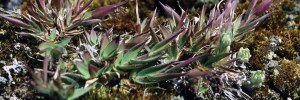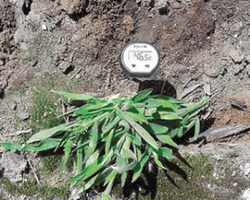“Interesting. So what?” – A Yellowstone Love Triangle

Photo courtesy Montana State University Thermal Biology Institute.
When I, Leysa, take my guests on tour I demonstrate how the seemingly little things in Yellowstone contribute to the bigger picture. For example, how small grubs, insects, and ground squirrels can feed some of the park’s biggest carnivores; how removing one apex predator can change an entire ecosystem; and how a fungus, a virus, a plant—and the symbiotic relationship between the three—can potentially affect humans’ ability to feed themselves in a changing climate.
Yellowstone is the geothermal capital of the world. It has around 10,000 hot springs, geysers, mudpots, and steam vents. Every single day visitors from across the planet are in awe at the striking array of blues, yellows, oranges, greens, and reds within Yellowstone’s hot springs that are almost always around boiling temperatures. Sitting around those hot springs is a plant called “ot springs panic grass.”
For most living creatures, growing in the hot, acidic soil around the thermal features is too close for comfort or even inhospitable. However, the panic grass survives and thrives right on the edge of hot springs in soil as hot as 149 degrees F.
Over the last few decades, researchers have looked closely at hot springs panic grass’s ability to survive where most life cannot. It was discovered that it is a fungus, called Curvularia protuberata, that coats the plant’s roots and confers its resistance to high temperatures. However, further research proves the fungus needs to be infected with Curvularia thermal tolerance virus (CThTV). This virus grants its tolerance to heat. Virus-free fungus cannot survive the roasting conditions and thus neither can the plant.
This three-way symbiotic relationship is necessary for survival in the thermal basins. Some may be thinking, “Interesting. So what?”

Photo courtesy NPS – Yellowstone
In the age of climate concern, drought and heat are the single greatest culprit of agricultural production loss. This infected fungus and its spores can be transferred to seeds and allow certain plants to grow in hotter conditions. Small biotech companies are having success transferring the fungal symbiont to the roots of bean sprouts, tomato plants, and others. According to Montana State University’s Dr. Brent Peyton, a spinoff biotechnology company is currently working to develop drought- and heat-tolerant crops after this discovery.
These are not things that are on most people’s bucket list when visiting Yellowstone, but they may play a larger role in our future than we anticipated – not to mention being one of the unexpected things visitors may experience and learn while on tour. Maybe someday, the symbiotic love triangle between these three will contribute to our bigger picture.

To learn more about Leysa and the rest of the Yellowstone Wild team visit our “About Us” webpage.
Content courtesy Yellowstone Wild Guide Leysa K. Photos courtesy Montana State University Thermal Biology Institute and National Park Service -Yellowstone.
